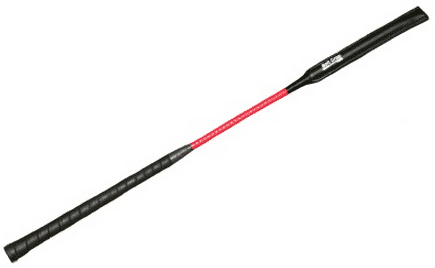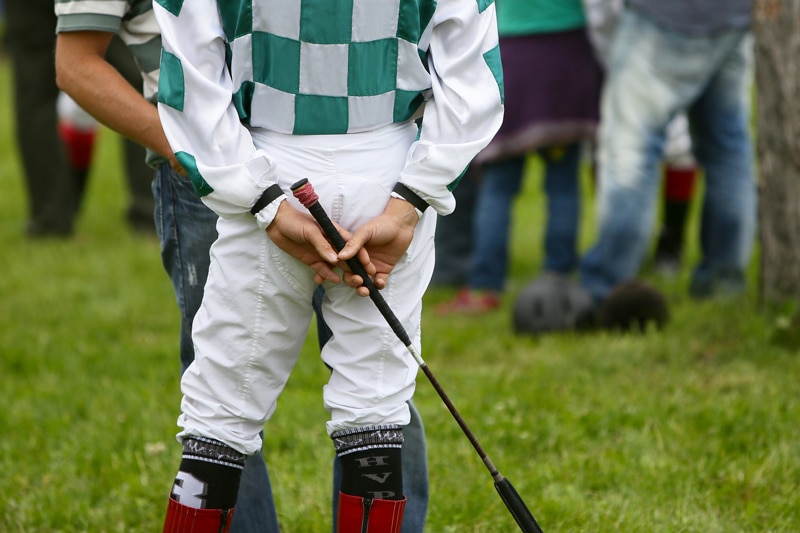Various racing jurisdictions recently have, or are in the midst of, revising rules to reduce whip use, at least partially in response to public concerns about equine welfare. The discussion over the excessive use of whips in the sport of horse racing has long been a contentious issue. Are whips really necessary? How many strikes is too many? How much does it hurt the horse?
The science is actually pretty clear.
A recent study supports previous studies from 2011 and 2012 that showed there was no benefit to whip use in a race. The study, led by the University of South Australia’s Dr Kirrilly Thompson and co-authored by the University of Sydney’s veterinarian and Professor Paul McGreevy, examined the stewards reports from 126 races in the UK, including 67 races ridden by apprentice jockeys who are allowed to carry, but not use, the whip.
All of the races were run on the same track and whip-free races were matched by track conditions, field size and race class with a whipping-permitted race. The stewards’ reports were then analysed for movement on course, interference and jockey behaviour. The study found there were no statistically significant differences between finishing times or any other factor, including safety. The study abstract can be found here:
The 2012 study had analyzed Australian race footage and was built on a study released in 2011 which found that whipping a horse does not increase the chance of a horse finishing first, second or third and that 98% of horses were being whipped without it influencing the race outcome.
The study assessed the area struck and the visual impact of whip use on horses and included a total of 350 rider-horse interactions. Two observers, working independently, found the following:
- The whip caused a visual indentation on the horse in 83% of impacts
- The unpadded section of the whip made contact on 64% of impacts
- At least 28 examples of apparent breaches of whip rules were found
- More than 75% of the time the whip struck the horse in the abdomen (or flank) where there is little muscling to absorb the impact.
- The majority of jockeys observed used a backhand whip action, possibly to avoid being penalized as, at the time of the study, the Australian whip rules maintained a focus solely on forehand action. Yet, there is no evidence that backhand whipping is less painful.
Whips for Speed
So why is whip use still staunchly supported by so many?
October 2nd marked the first program at Santa Anita since stricter whip rules were enacted by the California Horse Racing. These rules included not using the crop more than six times during a race, except for showing or waiving the crop or tapping the horse on the shoulder; not striking more than twice in succession within the six-strike limit; and using only in an underhanded position with the crop at or below the jockey’s shoulder level.
Quoted on DRF.com, Jockey Mike Smith said, “In my professional opinion, it’s not going to work. If you’re on a deep track and they’re tiring, it doesn’t work. It’ll cost somebody second money, a win, or third money.
“If you get one that wants to do it, it’s no problem. If they need to be encouraged, they’ll do something different every stride sometimes. It’s frustrating.”
Trainers will tell you that many horses need to be encouraged with the whip to try to the best of their ability. Months earlier at Monmouth Park, for example, Smith struck Authentic 10 times in rapid succession over the final 1/16th of a mile in the $1 million TVG.com Haskell Stakes. Did this enable the colt to hold off Ny Traffic by a nose?
Many believe it does. Jockey Isabelle Wenc says, “I believe that the whip in racing is used for both encouragement as well as correction. It’s instilled into horses from the get-go throughout their breaking as well as training into becoming racehorses. It’s used for encouragement because they’re taught that a tap with the stick means to be forward but it’s also used to correct a horse when they are refusing, lugging in or out or losing focus.”
Whips for Safety
Many jockeys and exercise riders are convinced, however, that accident prevention is an even more crucial role of the whip. For example, a tap on the shoulder can get a horse’s attention or stop them from drifting into another horse. Wenc agrees.

Horse Racing Whip with Soft Popper.
“In my personal opinion I think that taking it away would create a lot of safety issues both in the morning as far as exercising and then in the afternoons in races. I say that because I’ve personally been in instances where my stick has been beneficial to keeping a young horse on course or a troubled horse interested and in turn kept me and other riders safe. …[Plus] we have come a long way and have changed our rules here such as no over-handed hitting, nothing above the shoulder and a limited number of strikes. Our whips are also inspected and are required to have what we call a ‘soft touch popper’ or a 360° soft touch popper that was designed specifically in mind to be less invasive than the old standard leather popper whips.
“We as riders aren’t out there to hurt horses and are under a microscope at all times. If at any point a rider misuses their whip they are called in immediately for an explanation and are warned and if it happens again they are penalized and for each reoccurring offence the consequences get worse. You can be both fined and suspended for misuse of the whip.
“These are 1,200 pound animals running up to speeds of 40 mph that we are in charge of. Our intent is the horses’ safety, our fellow riders’ safety, and of course our own and the whip plays an important role in that especially with younger horses. At the end of the day we get on these animals because we love them and yes we make a living with them, but we wouldn’t be doing what we do if we didn’t care for them, so we do everything in our power to protect our livelihood as riders.”
While Wenc is willing to adapt to the new rules to show that the industry is taking welfare and public concerns into consideration, another jockey and exercise rider who requested anonymity expressed concern about the limitations, “To change the rule to a certain amount of strikes or to not use a whip is dangerous to riders. The current underhand rule leaves no room to hit the horse properly. You’ll always hit them illegally on the belly or stifle area. It’s physically impossible to reach far enough back with this rule considering the length of the stick we are allowed.”
Owner/trainer Ryan Deyotte also believes there is more at stake than wins. He says, “The purpose of the whip in racing is to not only encourage horses, but to give the jockeys who ride the horses better control of their mounts by helping with corrective steering issues and stopping them from making sudden and potentially dangerous manoeuvers in a race that could have catastrophic consequences. Overuse of the whip in the olden days was a potential problem, but with the implementation of kinder crops over the last decade the days of horses having big welts on them are almost non-existent.
“Taking whips out of the jockey’s hands is a dangerous proposition. Most of the people who want to do away with whips completely don’t understand the severity of the situation and I’ve found those that are barking the loudest have no thoroughbred racehorse riding experience or idea of how important having a crop is. I feel tracks like Woodbine have made strides in making things more transparent and have good rules that are upheld if jockeys overuse their crops. I think the rest of the horse racing communities across North America could pattern closely to the Woodbine model.” (In October 2019, Woodbine initiated a pilot project for new urging rules which included underhanded strikes only, no strikes with the whip in the cocked position and no hitting the horse in the belly or flank area.)
When asked if there could be racing without whips, he stated, “In the light of public views it’s two-fold. Animal lovers think it’s mean and want it gone, but the gamblers who fuel the industry with their gambling dollars want to see that jockeys are trying their best to win. Without a whip you will lose the gamblers.”
Handle loss is a major issue, however, it is unknown if gamblers would leave the sport if whips were banned or their use further restricted. Perhaps this is a survey long overdue? One could argue that as long as all riders are on a level playing field, they would still be trying their best to win. Hence some racing insiders are not convinced that whips are necessary in the future of racing.
One Woodbine owner, concerned about the impact of animal rights activism on the sport, said, “The whip encourages the horse… [but] I think for public perception, it may be wise to phase out the whip.”
Wenc disagrees. “The only reason I could see the whip ban benefiting the industry is it might keep people like PETA and other animal rights activists at bay ‒ but even still that will be short-lived because it won’t be long before they find something else in our industry to scrutinize.”
And yet one owner, also anonymous due to worries about repercussions from clients, said, “I think it’s a myth that horses run faster getting whipped towards the end of a race. I would love to see the industry change to a no-whip rule. I think it could put the racing industry in a better light and the general public and many non-horse people may enjoy watching racing more.”
So whether the whip is banned outright or only allowed for safety purposes instead of encouraging, the sport might attract a whole new group of fans to make up for the possible loss of current punters. What it will mean for changes in breeding decisions and training remains to be seen.
~ with research by Caitlin Eldridge



